Today, we offer updates on our economic and financial near-casts, focusing on our market regime views. As always, we focus on what the economic data tell us about the economy's current state, what markets tell us about expectations, and our systematic near-casting framework telling us about the near-term. Additionally, we show our Market Regime Portfolio, which applies our understanding of market-implied regimes and portfolio construction to give us a sense of the best exposures in the immediate term. Our observations are as follows:
Economic growth rates have decidedly ticked lower. Now, while GDP growth rates implied by our growth index have indeed turned lower, they are still elevated, which bodes well for risk assets.
Our systematic forecast points to inflation finding its peak level this month. We decompose CPI into its constituent categories and show our expected path for CPI and its subcomponents. The most recent print of CPI registered a strong trend in data, changing the level of our systematic forecasts but not the estimated trend.
Liquidity conditions are deteriorating. Broad liquidity growth has been long slowing, and policy liquidity has flatlined. While the liquidity picture is indeed deteriorating, risk assets remain resilient. We show how the analogous taper of 2013 shows us the potential path ahead in the event of policy liquidity withdrawal.
Markets are still pricing (+) G (+) I, but our systematic forecasts expect a shift to (+) G (-) I. While we have warned that markets will eventually begin to price the deterioration in growth and inflation rates, our market-implied regime odds continue to price rising growth and inflation. Our Market Regime Portfolio continues to prefer such exposures. However, our systematic market regime forecasts expect a transition in the next few months, and our systems expect a shift to (+) G (-) I.
It is likely (-) G (-) I (-) L will be the economic environment in the back half of the year. Combining our systematic forecasts for the economy and markets, our discretionary outlook for liquidity, and historical regime analysis, we programmatically estimate that the best asset class for a (-) G (-) I (-) L environment will be equities.
The future is dynamic, and our systems adjust as new information is available. Our bias is to allocate for the existing regime while trying to peek around the corner as to what the future may hold. Our Market Regime Portfolio aims to capture the current macroeconomic trend, and our systematic forecasts serve as our way of estimating what the next trend is likely to be.
The current market trend remains (+) G (+) I, but our systems estimate a handoff to (+) G (-) I over the next few months. This is coincident with an economy that will experience slowing but elevated economic growth and inflation, with the prospect of liquidity withdrawal. Our programmatic estimates, along with our discretionary analysis of analogous periods in history (2013 taper), tell us that equities will likely be the best performing asset class. Therefore, while our Market Regime Portfolio still prefers commodities exposure, our systems imply that commodities will soon hand off-market leadership to equities in Q4.
We discuss all this and more below.
Economic Growth: Slower, But High
Our Growth Index is our high-frequency measure of the growth impulse to GDP from a wide range of comprehensive economic data. The Growth Index has four subcomponents: risk premia, spending, production, and labor markets. The index measures economic activity at a higher frequency (monthly) and lower latency than quarterly GDP. Current economic data, which feeds the Growth Index, is currently pointing to 5.7% real GDP growth:
As we can see above, the Growth Index does a good job of estimating real GDP growth in real-time. The Growth Index has a directional accuracy of 88% in nowcasting real GDP growth. More importantly, unlike many regression-fitted estimates, our Growth Index actually has greater accuracy in nowcasting GDP downturns- our downside directional accuracy is 95%. When we think about our Growth Index, we prefer to focus not on the estimated magnitude of the nowcast but rather the acceleration or deceleration of the nowcast. As we can see above, our Growth Index implies GDP growth of 5.7% on a year-over-year basis, a further slowdown since our last publication where it was at 6.2%. Our systematic near casting framework points to GDP growth remaining elevated for the rest of the year. This bodes well for risk assets from a real-economic standpoint, as cashflows are likely to remain rising. However, from a market pricing perspective, this would not be as supportive as the current environment as the potential for downside surprises for data will increase as growth rates decelerate.
Inflation: At Peak Levels
Below, we show our systematic forecasts of CPI and its subcomponents. We include both a top-down estimate and a bottom-up estimate- obtained via forecasting each subcomponent. We show our CPI monitor below:
As we can see above, our top-down and bottom-up estimates concur about the future inflation trend- expecting a peak this month. As we can see, the systematic forecast is extremely elevated throughout the year. This is because our systematic forecasts are obtained using measures of trend and cyclicality, and recent prints have imposed a strong trend on the underlying data. Therefore, we are waiting and watching for the next print very carefully. If the inflation trend is indeed confirmed to be a “new normal,” we could have significantly higher inflation through the year. Our bias remains that inflation rates remain elevated, but the acceleration will subside. Nonetheless, we are carefully monitoring the pervasiveness and persistence of inflation to understand current inflation's stickiness.
Liquidity: Cracks Emerging
As part of our analytical framework, we assess the health of the countries’ income statement via growth and inflation and the health of its balance sheet via liquidity. Below, we show our Liquidity Monitor, where we show our broad liquidity measures available to the private sector, along with a heatmap with its major constituents. We also show how the composition of liquidity growth has changed on a rolling quarterly basis:
Cracks are emerging in the liquidity ecosystem, with broad liquidity growth slowing both annually and quarterly. Coincident with this slowdown in liquidity growth is a tightening of policy liquidity. As we explained in our last note:
“While liquidity is indeed abundant today, there is a shortage of collateral to park this new liquidity- particularly due to weakness in Treasury bill issuance. As a result, massive usage of the Reserves’ Reserve Repo Facility has led to a contraction in USD reserves. Therefore, incremental QE is now simply finding its way back to the Federal Reserve via reverse repo. We expect Treasury Bill issuance to remain weak as the Treasury spends its cash balance to achieve a cash balance of $450 billion by the end of July, creating a challenging situation for liquidity. Now, while reserves don’t make up a large share of total US liquidity, they are called “high-powered money” for a reason, reserve expansion and contraction have significant multiplier effects through the financial system. Therefore, due to the likelihood of continued reserve contraction and a potential balance sheet taper later this year, our outlook for liquidity is deteriorating.”
Given the improvement in the real economy, we think we are getting to a point where the Fed will be able to communicate a taper of its asset purchase program, i.e., liquidity withdrawal. To better understand the prospective path for assets during such an event, we look at historical analog. In particular, we look at asset price action during the last taper in 2013:
As we can see above, risk assets were particularly resilient during the last taper. Furthermore, equities actually posted the strongest returns of major asset classes. We attribute this to the stable growth and inflation environment achieved during this period. We expect a similar environment going into the end of this year, slowing but stable (and high) growth & inflation, with tightening policy liquidity. Therefore, it is entirely plausible that equities could once again be the best performing asset class during a tightening of policy liquidity. Now, while this analog does create a roadmap of sorts for expected asset class performance, the market regime will determine the realized performance of asset classes. We turn to this in the next section.
Market-Implied Regime: (+) G (+) I
Using the performance of various asset classes, we can extract what markets are implying which particular economic regime we are in. Below, we show what markets are telling us about the current growth and inflation regime:
As we have mentioned before, we can be in one of four regimes:
(+) G (-) I: Rising Growth, Falling Inflation
(+) G (+) I: Rising Growth, Rising Inflation
(-) G (+) I: Falling Growth, Rising Inflation
(-) G (-) I: Falling Growth, Falling Inflation
Using our understanding of asset markets, we can classify periods of time into one of the four regimes mentioned above. Further, we can use the regime obtained from our market-implied odds in conjunction with trend-following and cross-sectional momentum measures to create portfolio signals. To provide maximum accessibility, we truncate the portfolio construction into three stages:
Asset Class Selection: We create a portfolio that selects asset class exposure based on the current market-implied regime.
Sector Rotation: We create an equity rotation portfolio that chooses sectors based on their market-regime preference- to avoid overfitting, we choose these logically rather than based on our historical regime performance.
Unlevered Portfolio: We combine Asset Class Selection and Sector Rotation.
Market Regime Portfolio: Finally, we create our Market Regime Portfolio by ex-ante targeting equity volatility, i.e., we use leverage to match equity volatility.
Below, we show the results of this process versus major asset classes. Additionally, we show the performance characteristics over the decades since the 1970s:
As we can see above, our systematic Market Regime Portfolio has a strong performance across measures and is consistent over time. The portfolio is designed to be decisive and aggressive, wholly allocating to assets that prefer the current regime, with no diversifying exposures. Therefore, we take a significant signal from our market-implied regime signal. Since our last publication, (+) G (+) I asset class allocations to commodities have continued to pay off, but equity sector selections have been weak (financials, industrials, materials & energy). Overall, the market regime portfolio continues to post positive returns this month due to its aggressive (100%) allocation to broad commodities. Our current market-implied regime odds continue to point to us being in a (+) G (+) I environment, but the odds of (+) G (-) I are elevated as well. Peering around the corner, our systems estimate a hand-off from (+) G (+) I to (+) G (-) I around Q4.
Next Regime: (-) G (-) I (-) L
While we have defined the current regime using our market-implied regime odds, we also try to peer around the corner to see what the future may hold. To do so, we combine our systematic forecasts for the economy and markets, our discretionary outlook for liquidity, and historical regime analysis to understand the prospective path of major asset classes. Based on this triangulation, we think the next environment will likely be (-) G (-) I (-) L, i.e., falling growth, inflation, and liquidity. We programmatically estimate that the best asset class for this regime will be equities, and the worst asset class will be gold. We show this below:
Above, we show the implied price path of various assets, which are obtained quantitatively. Then, we overlay the normalized-historical returns during the next expected economic regime defined in terms of growth, inflation, and liquidity. We combine our systematic forecasts for the economy and markets, our discretionary outlook for liquidity, and historical regime analysis to understand the prospective path of major asset classes. Based on this triangulation, we programmatically estimate that the best asset class for a (-) G (-) I (-) L environment starting September would be equities, and the worst asset class will be gold. While indeed informative, we need to take these forecasts with a grain of salt- the future is dynamic, and to transition exposure before a market regime change would not be optimal. However, these triangulated forecasts help us understand what is to come and help us prepare for an eventual transition.
Conclusions
Economic growth is slower but elevated, and our systematic near-cast points to growth stay elevated for the rest of the year.
Our systematic forecast points to inflation finding its peak level this month.
Liquidity conditions are deteriorating, but it doesn’t mean risk assets will fall precipitously, as informed by history.
Markets are still pricing (+) G (+) I, but our systematic forecasts expect a shift to (+) G (-) I in Q4.
Overall, growth and inflation will remain elevated but stable according to our systems. Liquidity is contracting, but a policy liquidity withdrawal engaged for policy normalization should not damage risk assets excessively, as set by historical precedent. Markets are currently favoring (+) G (+) I, but our systems estimate that we will transition to (+) G (-) I by Q4. However, this could change if inflation proves to be “sticky” or in a persistently higher trend. If inflation does prove sticky, we would need to adjust our economic regime forecasts, and we will keep you updated. Until next time!



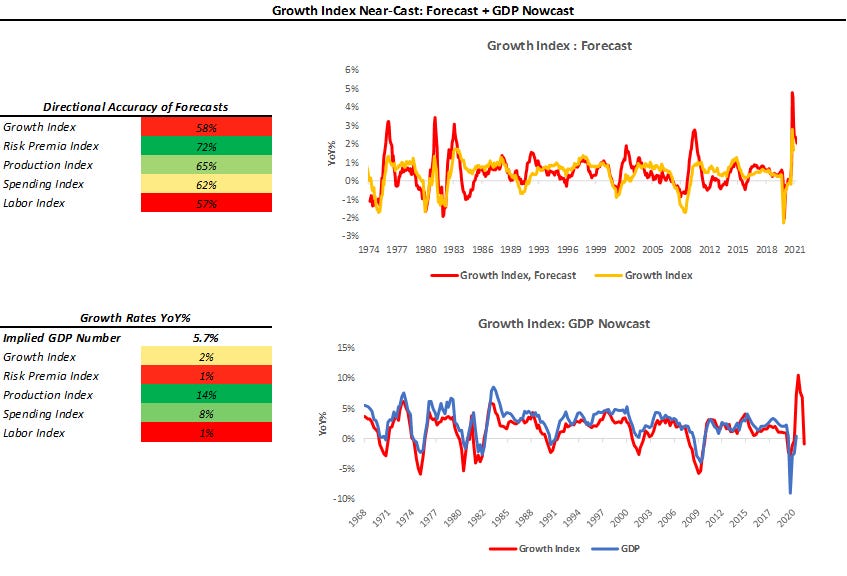

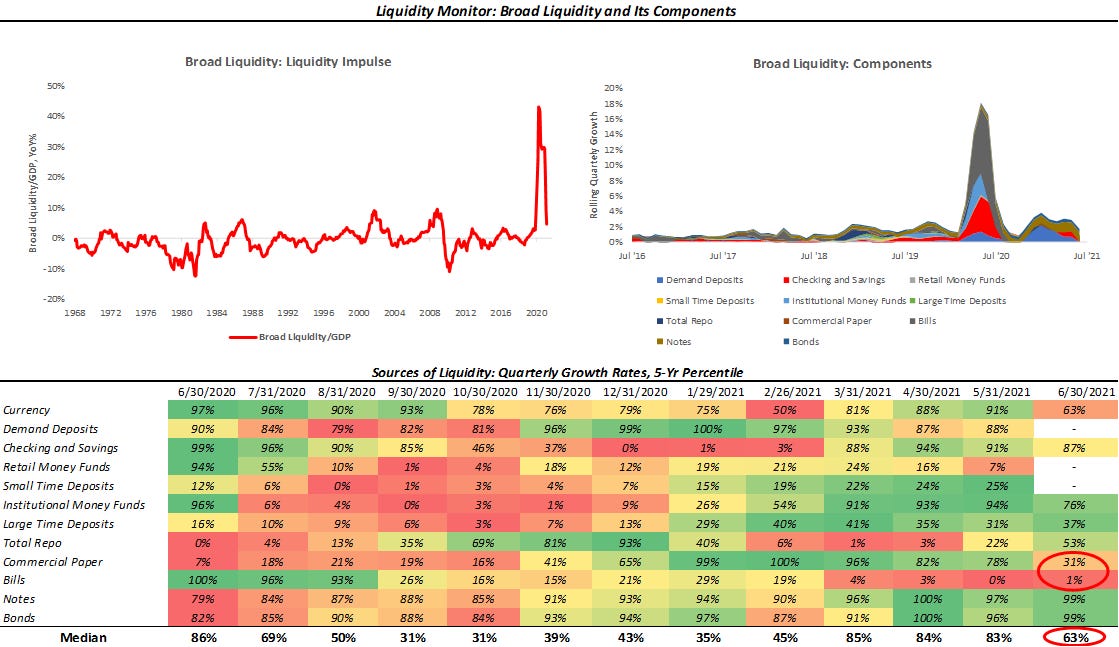
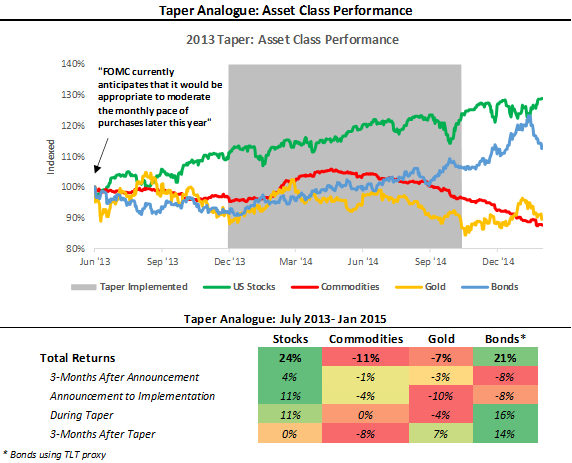
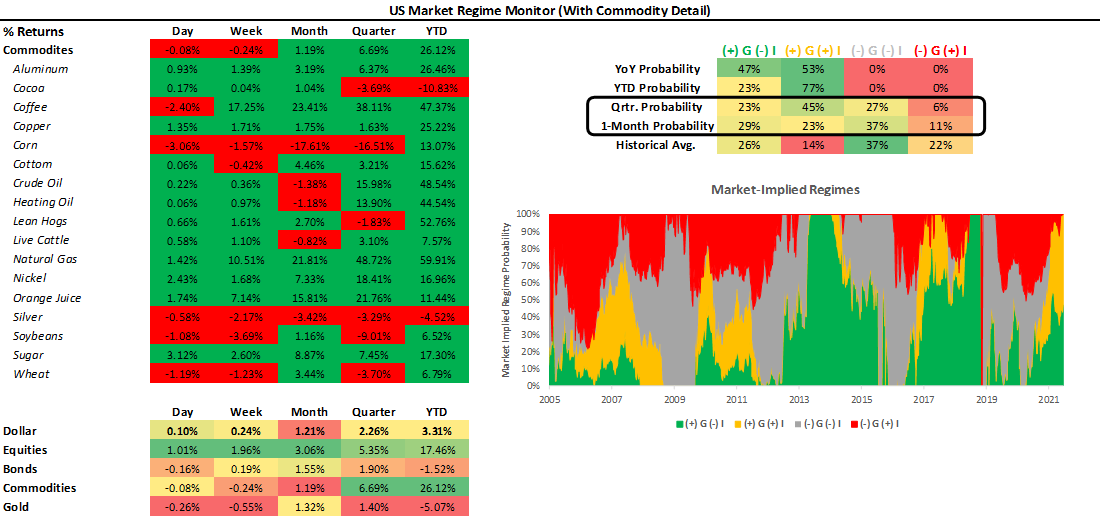
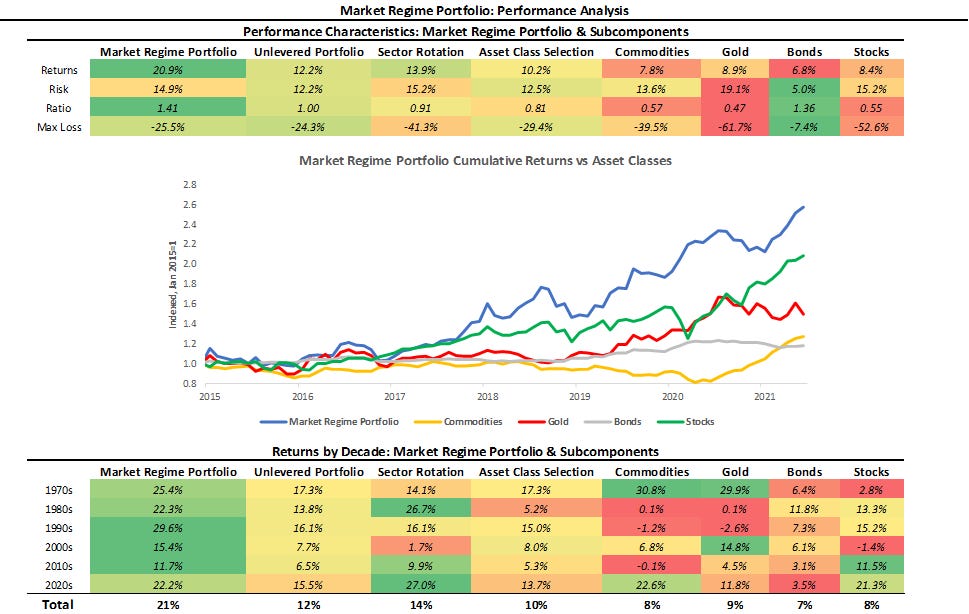

some of the best work on substack and beyond